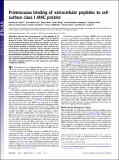| dc.contributor.author | Eisen, Herman N. | |
| dc.contributor.author | Hou, Xun Helen | |
| dc.contributor.author | Shen, Chase | |
| dc.contributor.author | Wang, Kaidi | |
| dc.contributor.author | Tanguturi, Varsha Keelara | |
| dc.contributor.author | Smith, Crysela | |
| dc.contributor.author | Kozyrytska, Katerina | |
| dc.contributor.author | Nambiar, Lakshmi | |
| dc.contributor.author | McKinley, Carol A. | |
| dc.contributor.author | Chen, Jianzhu | |
| dc.contributor.author | Cohen, Richard J. | |
| dc.date.accessioned | 2012-10-16T15:00:58Z | |
| dc.date.available | 2012-10-16T15:00:58Z | |
| dc.date.issued | 2012-03 | |
| dc.date.submitted | 2012-01 | |
| dc.identifier.issn | 0027-8424 | |
| dc.identifier.issn | 1091-6490 | |
| dc.identifier.uri | http://hdl.handle.net/1721.1/74019 | |
| dc.description.abstract | Algorithms derived from measurements of short-peptide (8–10 mers) binding to class I MHC proteins suggest that the binding groove of a class I MHC protein, such as K[superscript b], can bind well over 1 million different peptides with significant affinity (<500 nM), a level of ligand-binding promiscuity approaching the level of heat shock protein binding of unfolded proteins. MHC proteins can, nevertheless, discriminate between similar peptides and bind many of them with high (nanomolar) affinity. Some insights into this high-promiscuity/high-affinity behavior and its impact on immunodominant peptides in T-cell responses to some infections and vaccination are suggested by results obtained here from testing a model developed to predict the number of cell surface peptide–MHC complexes that form on cells exposed to extracellular (exogenous) peptides. | en_US |
| dc.description.sponsorship | Massachusetts Institute of Technology. Undergraduate Research Opportunities Program | en_US |
| dc.language.iso | en_US | |
| dc.publisher | National Academy of Sciences | en_US |
| dc.relation.isversionof | http://dx.doi.org/10.1073/pnas.1201586109 | en_US |
| dc.rights | Creative Commons Attribution | en_US |
| dc.rights.uri | http://creativecommons.org/licenses/by/2.5/ | en_US |
| dc.source | PNAS | en_US |
| dc.title | Promiscuous binding of extracellular peptides to cell surface class I MHC protein | en_US |
| dc.type | Article | en_US |
| dc.identifier.citation | Eisen, H. N. et al. “Promiscuous Binding of Extracellular Peptides to Cell Surface Class I MHC Protein.” Proceedings of the National Academy of Sciences 109.12 (2012): 4580–4585. ©2012 by the National Academy of Sciences | en_US |
| dc.contributor.department | Harvard University--MIT Division of Health Sciences and Technology | en_US |
| dc.contributor.department | Massachusetts Institute of Technology. Department of Biology | en_US |
| dc.contributor.department | Koch Institute for Integrative Cancer Research at MIT | en_US |
| dc.contributor.mitauthor | Eisen, Herman N. | |
| dc.contributor.mitauthor | Hou, Xun Helen | |
| dc.contributor.mitauthor | Shen, Chase | |
| dc.contributor.mitauthor | Wang, Kaidi | |
| dc.contributor.mitauthor | Tanguturi, Varsha Keelara | |
| dc.contributor.mitauthor | Smith, Crysela | |
| dc.contributor.mitauthor | Kozyrytska, Katerina | |
| dc.contributor.mitauthor | Nambiar, Lakshmi | |
| dc.contributor.mitauthor | McKinley, Carol A. | |
| dc.contributor.mitauthor | Chen, Jianzhu | |
| dc.contributor.mitauthor | Cohen, Richard J. | |
| dc.relation.journal | Proceedings of the National Academy of Sciences | en_US |
| dc.eprint.version | Final published version | en_US |
| dc.type.uri | http://purl.org/eprint/type/JournalArticle | en_US |
| eprint.status | http://purl.org/eprint/status/PeerReviewed | en_US |
| dspace.orderedauthors | Eisen, H. N.; Hou, X. H.; Shen, C.; Wang, K.; Tanguturi, V. K.; Smith, C.; Kozyrytska, K.; Nambiar, L.; McKinley, C. A.; Chen, J.; Cohen, R. J. | en |
| dc.identifier.orcid | https://orcid.org/0000-0002-5573-0137 | |
| dc.identifier.orcid | https://orcid.org/0000-0002-5687-6154 | |
| mit.license | PUBLISHER_CC | en_US |
| mit.metadata.status | Complete | |
